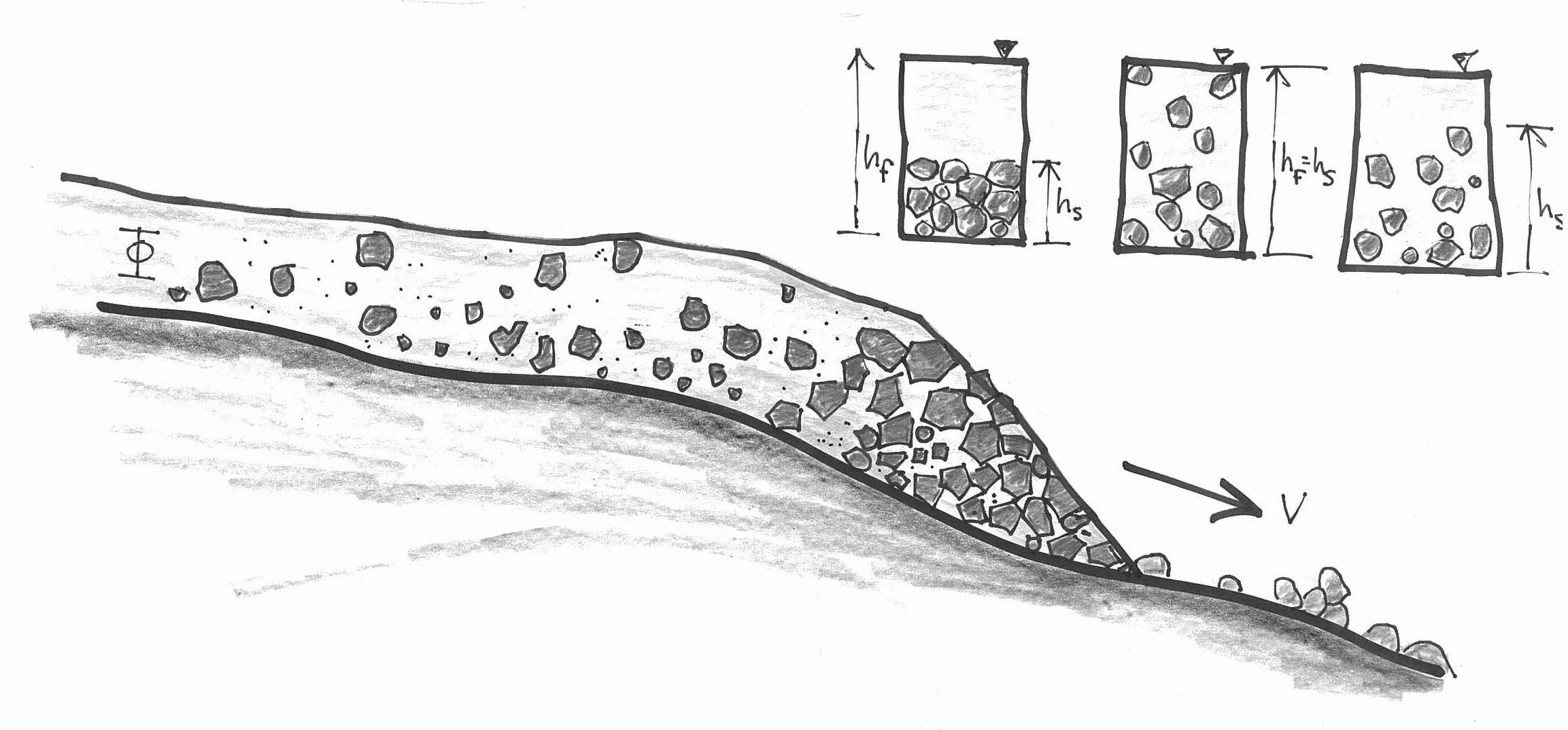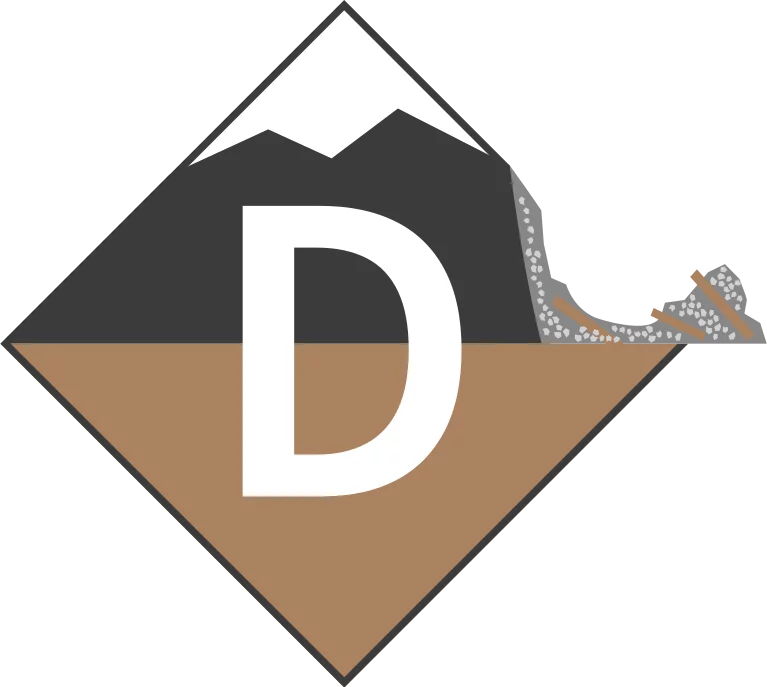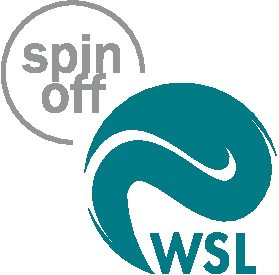RAMMS::Debrisflow
The RAMMS::Debrisflow module was developed to simulate the runout of muddy and debris-laden flows in complex terrain. The module is used in Switzerland and worldwide for debris flow hazard analysis and to aid in the design mitigation measures. It combines state-of-the-art numerical solution methods with helpful input features and user-friendly visualization tools. Many of the input and output features have been optimized to allow engineers and geoscientists to define event scenarios, evaluate simulation results, and predict the influence of proposed structural mitigation measures on the runout of debris flows.

Theory
The core of the program is an efficient second-order numerical solution of the depth-averaged equations of motion (the shallow water equations) for granular flows. Flow heights and velocities are calculated on three-dimensional digital terrain models. Single or multiple block-release (initiation) areas are easily specified using GIS-type drawing tools; alternatively an input hydrograph can be used to specify the discharge as a function of time. Users are provided with useful overview information related to simulations, such as release area (mean slope, total volume), flow behavior (max. flow velocities and heights) and stopping behaviour (mass flux). Maps and remote-sensing imagery can be superimposed on the terrain models to aid the specification of input conditions and facilitate the calibration of the model with historical event data.
The numerical model uses the two-parameter Voellmy relation to describe the frictional behaviour of the flowing debris. This relation has been shown by others to be useful for modeling the runout of debris flows and other flowing landslides. To calibrate the RAMMS Voellmy model, users generally simulate well-documented historical events and determine the best-fit parameter sets which can be used in subsequent analyses. Additional features include the ability to export the results to GIS as well as the ability to modify the topography to include deposits from a previously-modelled surge or to include constructional migitation measures (e.g. retention or deflection dams), thereby allowing users to evaluate the influence of previous flows or mitigation measures, respectively, on the runout of future debris flows.
The numerical model uses the two-parameter Voellmy relation to describe the frictional behaviour of the flowing debris.
RAMMS provides the option to use an input hydrograph or a block release to start the model.
Downloads
RAMMS::Debrisflow
Publications
Debrisflow Publications List
Bolliger D., Schlunegger F., McArdell B.W. (2024) Comparison of debris flow observations, including fine-sediment grain size and composition and runout model results, at Illgraben, Swiss Alps. Nat. Hazards Earth Syst. Sci. 24(3), 1035-1049. doi:10.5194/nhess-24-1035-2024 Institutional Repository DORA
Könz A.L., Hirschberg J., McArdell B.W., Mirus B.B., de Haas T., Bartelt P., Molnar P. (2024) Debris-flow entrainment modelling under climate change: Considering antecedent moisture conditions along the flow path. Earth Surf. Process. Landf. doi:10.1002/esp.5868 Institutional Repository DORA
Meyrat G., Munch J., Cicoira A., McArdell B., Müller C.R., Frey H., Bartelt P. (2024) Simulating glacier lake outburst floods (GLOFs) with a two-phase/layer debris flow model considering fluid-solid flow transitions. Landslides. 21(479), 497. doi:10.1007/s10346-023-02157-w Institutional Repository DORA
Berger C., Zimmermann F., Mauerhofer R., Christen M. (2023) MurGame: Protect your village from debris flows!. In M. Pirulli, A. Leonardi, & F. Vagnon (Eds.), E3S web of conferences: Vol. 415. 8th international conference on debris flow hazard mitigation (DFHM8). Les Ulis Cedex A: EDP Sciences. 07002 (4 pp.). doi:10.1051/e3sconf/202341507002 Institutional Repository DORA
Hirschberg J., McArdell B.W., Könz A.L., Christen M., Molnar P., Bartelt P. (2023) Entrainment maps considering hydrological conditions for mass movement runout modelling: application to debris-flow bulking at Pizzo Cengalo. In M. Pirulli, A. Leonardi, & F. Vagnon (Eds.), E3S web of conferences: Vol. 415. 8th international conference on debris flow hazard mitigation (DFHM8). Les Ulis Cedex A: EDP Sciences. 01010 (4 pp.). doi:10.1051/e3sconf/202341501010 Institutional Repository DORA
McArdell B.W., Hirschberg J., Aaron J., Badoux A. (2023) Evaluation of a method to calculate debris-flow volume based on observations of flow depth. In M. Pirulli, A. Leonardi, & F. Vagnon (Eds.), E3S web of conferences: Vol. 415. 8th international conference on debris flow hazard mitigation (DFHM8). Les Ulis Cedex A: EDP Sciences. 02012 (4 pp.). doi:10.1051/e3sconf/202341502012 Institutional Repository DORA
Meyrat G., Bartelt P., McArdell B. (2023) A dilatant two-phase debris flow model with erosion validated by full-scale field data from the Illgraben test station. In M. Pirulli, A. Leonardi, & F. Vagnon (Eds.), E3S web of conferences: Vol. 415. 8th international conference on debris flow hazard mitigation (DFHM8). Les Ulis Cedex A: EDP Sciences. 01015 (4 pp.). doi:10.1051/e3sconf/202341501015 Institutional Repository DORA
Meyrat G., McArdell B., Müller C.R., Munch J., Bartelt P. (2023) Voellmy-type mixture rheologies for dilatant, two-layer debris flow models. Landslides. 20, 2405-2420. doi:10.1007/s10346-023-02092-w Institutional Repository DORA
Barnhart, K.R.; Jones, R.P.; George, D.L.; McArdell, B.W.; Rengers, F.K.; Staley, D.M.; Kean, J.W., 2021: Multi-model comparison of computed debris flow runout for the 9 January 2018 Montecito, California Post-Wildfire Event. Journal of Geophysical Research F: Earth Surface, 126, 12: e2021JF006245 (33 pp.). doi: 10.1029/2021JF006245
Meyrat, G.; McArdell, B.; Ivanova, K.; Müller, C.; Bartelt, P., 2022: A dilatant, two-layer debris flow model validated by flow density measurements at the Swiss illgraben test site. Landslides, 19: 265-276. doi: 10.1007/s10346-021-01733-2
Berger C., Denk M., Graf C., Stieglitz L., Wendeler C. (2021) Practical guide for debris flow and hillslope debris flow protection nets. WSL Berichte: Vol. 113. Birmensdorf: Swiss Federal Institute for Forest, Snow and Landscape Research WSL. 79 p. Institutional Repository DORA
Zimmermann, F.; McArdell, B.W.; Rickli, C.; Scheidl, C., 2020: 2D runout modelling of hillslope debris flows, based on well-documented events in Switzerland. Geosciences, 10, 2: 70 (17 pp.). doi: 10.3390/geosciences10020070
Graf, C.; Christen, M.; McArdell, B.W.; Bartelt, P., 2019: An overview of a decade of applied debris-flow runout modeling in Switzerland: challenges and recommendations. In: Kean, J.W.; Coe, J.A.; Santi, P.M.; Guillen, B.K. (eds), 2019: Debris-flow hazards mitigation: mechanics, monitoring, modeling, and assessment. 7th intemational conference on debris-flow hazards mitigation (DFHM7), Golden, USA. 685-692.
De Haas, T.; McArdell, B.W.; Conway, S.J.; McElwaine, J.N.; Kleinhans, M.G.; Salese, F.; Grindrod, P.M., 2019: Initiation and flow conditions of contemporary flows in Martian gullies. Journal of Geophysical Research: Planets, 124, 8: 2246-2271. doi: 10.1029/2018JE005899
Frey, H.; Huggel, C.; Chisolm, R.E.; Baer, P.; McArdell, B.; Cochachin, A.; Portocarrero, C., 2018: Multi-source glacial lake outburst flood hazard assessment and mapping for Huaraz, Cordillera Blanca, Peru. Frontiers in Earth Science, 6: 210 (16 pp.). doi: 10.3389/feart.2018.00210
Frank, F.; McArdell, B.W.; Oggier, N.; Baer, P.; Christen, M.; Vieli, A., 2017: Debris-flow modeling at Meretschibach and Bondasca catchments, Switzerland: sensitivity testing of field-data-based entrainment model. Natural Hazards and Earth System Science, 17, 5: 801-815. doi: 10.5194/nhess-17-801-2017
Fan, L.; Lehmann, P.; McArdell, B.; Or, D., 2017: Linking rainfall-induced landslides with debris flows runout patterns towards catchment scale hazard assessment. Geomorphology, 280: 1-15. doi: 10.1016/j.geomorph.2016.10.007
Bartelt, P.; McArdell, B.; Graf, C.; Christen, M.; Buser, O., 2016: Dispersive pressure, boundary jerk and configurational changes in debris flows. International Journal of Erosion Control Engineering, 9, 1: 1-6. doi: 10.13101/ijece.9.1
Berger, C.; Christen, M.; Speerli, J.; Lauber, G.; Ulrich, M.; McArdell, B.W., 2016: A comparison of physical and computer-based debris flow modelling of a deflection structure at Illgraben, Switzerland. In: Koboltschnig, G. (eds), 2016: 13th congress INTERPRAEVENT 2016. 30 May to 2 June 2016. Lucerne, Switzerland. Conference proceedings “Living with natural risks”. 13th congress INTERPRAEVENT 2016, Lucerne, Switzerland, May 30-June 2, 2016. 212-220.
Frank, F.; McArdell, B.W.; Huggel, C.; Vieli, A., 2015: The importance of entrainment and bulking on debris flow runout modeling: examples from the Swiss Alps. Natural Hazards and Earth System Science, 15, 11: 2569-2583. doi: 10.5194/nhess-15-2569-2015
Walser, M.; Huggel, C.; McArdell, B.; Graf, C., 2014: Gefahrenkartierung von Murgängen. Numerische Modellsimulationen im Vergleich zu empirischen, analytischen Methoden. Wasser, Energie, Luft, 106, 3: 215-218.
Walser, M.; McArdell, B.; Huggel, C.; Graf, C., 2014: Inwiefern eignen sich numerische Modellsimulationen für die Gefahrenkartierung von Murgängen – ein Vergleich. FAN Agenda, Fachleute Naturgefahren Schweiz, 21-23.
Hohermuth, B.; Graf, C., 2014: Einsatz numerischer Murgangsimulationen am Beispiel des integralen Schutzkonzepts Plattenbach Vitznau. Wasser, Energie, Luft, 106, 4: 285-290.
Graf, C.; Deubelbeiss, Y.; Bühler, Y.; Meier, L.; McArdell, B.; Christen, M.; Bartelt, P., 2013: Gefahrenkartierung Mattertal: Grundlagenbeschaffung und numerische Modellierung von Murgängen. In: Graf, C. (eds), 2013: Mattertal – ein Tal in Bewegung. Jahrestagung der Schweizerischen Geomorphologischen Gesellschaft, St. Niklaus, June 29 – July 1, 2011. 85-112.
Scheidl, C.; Rickenmann, D.; McArdell, B.W., 2013: Runout prediction of debris flows and similar mass movements. In: Margottini, C.; Canuti, P.; Sassa, K. (eds), 2013: Landslide science and practice. Vol. 3. Heidelberg, Springer. 221-229. doi: 10.1007/978-3-642-31310-3_30
Bühler, Y.; Graf, C., 2013: Sediment transfer mapping in a high-alpine catchment using airborne LiDAR. In: Graf, C. (eds), 2013: Mattertal – ein Tal in Bewegung. Jahrestagung der Schweizerischen Geomorphologischen Gesellschaft, St. Niklaus, June 29 – July 1, 2011. 113-124.
Raïmat, C.; Riera, E.; Graf, C.; Luis-Fonseca, R.; Fañanas Aguilera, C.; Hürlimann, M., 2013: Experiencia de la aplicación de RAMMS para la modelización de flujo tras la aplicación de la soluciones flexibles vx en el barranc de Portainé. In: Alonso, E.; Corominas, J.; Hürlimann (eds), 2013: VIII Simposio Nacional sobre Taludes y Laderas Inestables, Palma de Mallorca, Junio 2013. 1131-1144.
Deubelbeiss, Y.; Graf, C., 2013: Two different starting conditions in numerical debris-flow models – case study at Dorfbach, Randa (Valais, Switzerland). In: Graf, C. (eds), 2013: Mattertal – ein Tal in Bewegung. Jahrestagung der Schweizerischen Geomorphologischen Gesellschaft, St. Niklaus, June 29 – July 1, 2011. 125-138.
Simoni, A.; Mammoliti, M.; Graf, C., 2012: Performance of 2D debris flow simulation model RAMMS. Back-analysis of field events in Italian Alps. In: 2012: Annual international conference on geological and earth sciences (GEOS 2012), Singapore. (6 pp.).
Hussin, H.Y.; Quan Luna, B.; Van Westen, C.J.; Christen, M.; Malet, J.-P.; Van Asch, Th.W.J., 2012: Parameterization of a numerical 2-D debris flow model with entrainment: a case study of the Faucon catchment, Southern French Alps. Natural Hazards and Earth System Science, 12, 10: 3075-3090. doi: 10.5194/nhess-12-3075-2012




